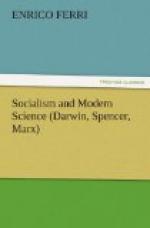The fundamental thesis of Socialism is then, to repeat it again, in perfect harmony with that sociological law of apparent retrogression, the natural reasons for which have been so admirably analyzed by M. Loria, thus: the thought and the life of primitive mankind are moulded and directed by the natural environment along the simplest and most fundamental lines; then the progress of intelligence and the complexity of life increasing by a law of evolution give us an analytical development of the principal elements contained in the first genus of each institution; this analytical development is often, when once finished, detrimental to each one of its elements; humanity itself, arrived at a certain stage of evolution, reconstructs and combines in a final synthesis these different elements, and thus returns to its primitive starting-point.[54]
This reversion to primitive forms is not, however, a pure and simple repetition. Therefore it is called the law of apparent retrogression, and this removes all force from the objection that socialism would be a “return to primitive barbarism.” It is not a pure and simple repetition, but it is the concluding phase of a cycle, of a grand rhythm, as M. Asturaro recently put it, which infallibly and inevitably preserves in their integrity the achievements and conquests of the long preceding evolution, in so far as they are vital and fruitful; and the final outcome is far superior, objectively and subjectively, to the primitive social embryo.
The track of the social evolution is not represented by a closed circle, which, like the serpent in the old symbol, cuts off all hope of a better future; but, to use the figure of Goethe, it is represented by a spiral, which seems to return upon itself, but which always advances and ascends.
FOOTNOTES:
[50] L. DRAMARD, Transformisme et socialisme, in Revue Socialiste, Jan. and Feb., 1885.
[51] Divorzio e sociologia, in Scuola positiva nella geurisprudenza penale, Rome, 1893, No. 16.
[52] It is known that Aristotle, mistaking for an absolute sociological law a law relative to his own time, declared that slavery was a natural institution, and that men were divided, by Nature, into two classes—free men and slaves.
[53] SPENCER, Principles of Sociology, Vol. II, Part. V., Chap. XV., p. 553. New York, 1897. D. Appleton & Co.
This idea, which Spencer had expressed in 1850 in his Social Statics is found again in his recent work, Justice (Chap. XI, and Appendix 3). It is true that he has made a step backward. He thinks that the amount of the indemnity to be given to the present holders of the land would be so great that this would make next to impossible that “nationalization of the land” which, as long ago as 1881, Henry George considered as the only remedy, and that Gladstone had the courage to propose as a solution of the Irish question. Spencer adds: “I adhere to the inference originally drawn, that the aggregate of men forming the community are the supreme owners of the land, but a fuller consideration of the matter has led me to the conclusion that individual ownership, subject to State suzerainty, should be maintained.”




